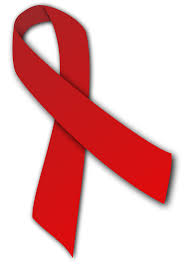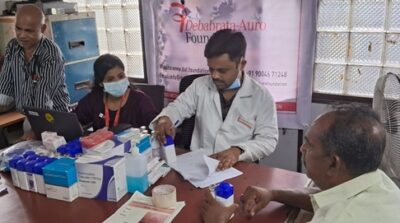‘Predicting the exact nature of future pandemics is challenging; Focus should be on vigilance and preparedness’
During the interaction, Dr. Solomon and Cloherty revealed that their ongoing focus is to expand our network globally and enhance capacity across all regions. Human Immunodeficiency Virus (HIV) is a chronic viral infection that can progress into

During the interaction, Dr. Solomon and Cloherty revealed that their ongoing focus is to expand our network globally and enhance capacity across all regions.
Human Immunodeficiency Virus (HIV) is a chronic viral infection that can progress into a life-threatening condition known as Acquired Immunodeficiency Syndrome (AIDS). An estimated 850,000 people inject drugs in India and HIV prevalence amongst them is estimated to be 9.3 per cent.
Experts maintain the HIV epidemic in India remains a public health issue and outbreaks can easily move from one area of the country to another as people migrate.
India has the third highest absolute burden of HIV in the world with an estimated 2.3 million PLHIV in 2021 of which 63 thousand were newly infected, while 42 thousand annual deaths were attributable to the disease. Furthermore, only 77 percent PLHIV were aware of their diagnosis and only 65 percent PLHIV were initiated on ART therapy. From the perspective of a developing and youthful lower middle-income country such as India, HIV/AIDS severely undermines health, and social and economic development.
To control and end the AIDS epidemic in India, the National AIDS Control Organization (NACO), under the Ministry of Health and Family Welfare (MoHFW) beginning since 1992, has undertaken five phases of the National AIDS Control Program (NACP). It has achieved substantial success in lowering the annual incidence of new HIV infections by two-thirds and death rate by more than half (54%) in the past two decades. Although overall prevalence is low, there is significant regional disparity among states, with higher averages in Mizoram, Nagaland, and Manipur.
It is noteworthy that various non-profit organisations are also working to combat the growing epidemic of HIV, especially in high-risk geographies. In India, Abbott Pandemic Defense Coalition (APDC) in collaboration with YRGCARE Foundation is providing support to individuals affected by or vulnerable to HIV and other infectious diseases in these areas through the provision of holistic care including testing, treatment and counseling, and other support services.
Interestingly, APDC is an industry-led global scientific and public health partnership dedicated to the early detection of and rapid response to future pandemic threats. The coalition, along with its partners across the globe focusses on identifying, tracking, analysing and testing emerging threats to stay one step ahead of the next viral threat.
In an exclusive interaction with Financial Express.com, Dr. Gavin Cloherty, Head of Infectious Disease Research at Abbott’s diagnostic business and Sunil Solomon, Chairman, YRGCARE talked about the need to remain vigilant and proactive in identifying and understanding potential threats before they escalate.
Dr. Gavin is head of Infectious Disease Research for Abbott’s diagnostics business. He provides scientific leadership in infectious disease diagnostics by conducting groundbreaking clinical studies on hepatitis and HIV and developing new tests. As one of the top experts in the field, his innovative research is changing the way infectious diseases are being diagnosed to help improve patient outcomes.
HIV in India
On the status of HIV and its impact in India, Dr. Solomon revealed that most efforts were directed towards preventing sexual transmission of HIV.
“While this approach has led to a decline in HIV rates among the general population, it has not adequately addressed other high-risk groups. These include people who inject drugs, men who have sex with men, and the transgender community, where infection rates remain alarmingly high. To put this into perspective, the HIV prevalence in the general population is about 0.2 percent, whereas it skyrockets to 9.3 percent among drug-using populations, making it almost 45 times higher in these groups. This disparity highlights the heterogeneity in the response to the HIV epidemic,” Dr. Solomon told Financial Express.com.
Dr. Solomon serves as the Chairman of the YR Gaitonde Medical Educational and Research Foundation, Chennai, India. He is currently a Professor of Medicine and Epidemiology, in the Division of Infectious Diseases, at the Johns Hopkins University School of Medicine and serves as the Co-Director of the Johns Hopkins Center for Infectious Diseases in India.
He also revealed that while the government has done commendable work, there is a pressing need to innovate care models to reach these underserved populations.
“My work primarily focuses on drug-using communities, and it’s evident that merely urging people to get tested isn’t enough. When we engage with these communities, they often express that basic survival needs, like food and shelter, take precedence over health concerns. A pivotal moment in our approach occurred when we were at Yamuna Bazaar in Delhi. We saw an opportunity to repurpose a small shed into a community hub. This initiative, shared with my colleague Gavin, aimed to see if addressing the immediate needs of the community could improve access to diagnostics and care. We realized that while finding solutions for new health challenges is crucial, tackling existing pandemics with available resources is equally vital. This led us to develop a holistic model of care,” Dr. Solomon highlighted.
He also said that their project in Delhi, known as the “Blue Shed” provides a range of services for people who inject drugs.
“Beyond the essential services like opioid substitution, needle exchange, and treatment for common ailments, we focus on providing access to clean water, showers, and toilets. These basic amenities are often the primary draw for individuals. Once they come in, we offer screenings for HIV and Hepatitis B while they wait for their turn,” he said.
Recently, Abbott and YRGCARE opened two new facilities dedicated to helping stop the spread of HIV. The organization claimed that the initiative aims to transform the lives of over 2500 people in these cities over the next year by taking a “holistic approach” for those who have or are at-risk for HIV and other known or emerging infectious diseases.
YRGCARE began providing support for people who at risk for HIV in Delhi in 2012, particularly for PWID (people who inject drugs), as transmission of HIV, hepatitis and other infectious diseases is higher amongst this group. The non-profit has been collaborating with Abbott since 2014 to support people beyond the scope of the HIV care continuum.
The first facility, called “The Blue Shed,” is based in Delhi’s Yamuna Bazar, a hotspot for HIV transmission amongst its largely transient population. The new facility will offer testing, treatment and counselling, and other support services to provide holistic support for those who have or are at-risk for HIV and other known or emerging infectious diseases.
Interestingly, the facility features a laboratory for on-site testing, which will enable the detection of known and emerging infectious diseases to help better track outbreaks.
Beyond testing, the facility helps provide linkages to government-run Opioid Substitution Therapy (OST) and Antiretroviral Therapy (ART), as well as tuberculosis treatments when needed. Currently, more than 600 individuals are registered with the clinic, and this number is growing every day.
In Mizoram, YRGCARE recently opened an adolescent center in Aizawl to serve at-risk youth who are vulnerable to HIV and other sexually transmitted infections. In addition to testing through the support of the Abbott Pandemic Defense Coalition, the Center offers access to treatment and other healthcare services, counselling and mental health services and guidance programs. Over 1600 young people have enrolled and this number is increasing.
Both Dr. Cloherty and Dr. Solomon reiterated that pandemic preparedness isn’t just about hunting for the next, new virus, but helping to address the current epidemics such as HIV and hepatitis.
Moreover, Dr. Solomon also highlighted that their work in India has focused significantly on monitoring existing pandemics such as HIV and viral hepatitis with little bit of SARS – CoV- 2.
“We engage with various communities, including lower-income groups and specific populations like MSM (men who have sex with men) and trans communities, through numerous community-level clinics. During the recent MPOX (monkeypox) outbreaks, our network responded swiftly by developing and distributing tests to our partners within a month. This preparedness enabled rapid response and containment efforts. Additionally, we’re exploring innovative methods for surveillance, such as integrating electronic medical records (EMR) for monitoring,” he told Financial Express.com.
In Kerala, for example, we evaluated the feasibility of using EMR systems in private hospitals to detect and report surveillance signals to the Integrated Disease Surveillance Program (IDSP), he said.
“This model proved effective, finding numerous signals over a six-month period. A similar approach was implemented at Rush University Medical Center in Chicago, where EMR data was used to monitor influenza-like illnesses and identified a handful of cases that warranted further investigation. Overall, the “virus hunters” are a diverse group working together to monitor, identify, and combat emerging health threats. This collaborative and comprehensive approach helps advance
science and enhance public health preparedness globally,” he explained.
‘Need to identify gaps’
While talking about the need to focus on a comprehensive approach, Dr. Solomon highlighted that there is an ongoing need to address the gaps in healthcare delivery to manage the heterosexual epidemic effectively.
“It’s also essential to understand the interconnected nature of different HIV risk groups. The epidemic isn’t isolated among heterosexual people or drug users; there’s a significant overlap. Individuals who inject drugs often engage in risky behaviors that increase their vulnerability to HIV transmission,” he pointed out.
To effectively combat the epidemic, we must address these overlapping groups. Our approach involves identifying gaps in the current government response and developing models that can be integrated into existing programs, he maintained.
Meanwhile, Dr Cloherty highlighted that their work involves tracking the genetic analysis and evolution of the HIV virus. To this Dr. Solomon added that this research is crucial for developing effective diagnostics, treatments, and vaccines.
“Just as the global response to SARS-CoV-2 has shown the importance of tracking variants like Omicron and Delta, our studies on HIV’s genetic changes ensure that diagnostic tests remain sensitive and accurate across all virus strains. The ability to understand and monitor how HIV evolves globally allows us to create diagnostics that are reliable, regardless of where the virus originates. This approach ensures that individuals tested for HIV can trust the accuracy of their results, whether
positive or negative. This is a unique programme that anybody has at this scale where we are actively looking at how these viruses are changing all around the world. It doesn’t matter where you get yourself tested or where the virus comes from. You can rely on the results you get it whether it is positive or negative, he explained.
‘Predicting future pandemics is challenging’
Since its launch in 2021, APDC is identifying, tracking, analyzing and testing emerging threats around the globe, including COVID-19 variants. According to Cloherty, predicting the exact nature of future pandemics is challenging and not necessarily the most effective approach.
“Instead, we should focus on vigilance and preparedness. We know certain types of viruses and viral families pose risks and have the potential to cause significant diseases. However, pinpointing where or when the next outbreak will occur with complete certainty is impossible and could lead to a false sense of security if we think too narrowly. Our strategy involves maintaining a broad perspective. This is why our network encompasses 22 partners across five continents, examining diverse populations and environments,” he told Financial Express.com.
The ‘One Health’ approach, which considers the interconnectedness of human, animal, and environmental health, is crucial, particularly regarding zoonotic diseases—those transmitted from animals to humans.
“While zoonotic transmission is important, our primary focus remains on the human element. If a virus infects a person, it’s clear that it has the potential to cause human disease. When we look for viruses in animals, there’s always the uncertainty of whether those viruses can infect humans. However, when we monitor humans, especially those in close contact with animals—a situation that’s becoming more common due to factors like migration and environmental changes—we can more effectively assess the risks,” Dr. Cloherty explained.
Climate change is a significant factor in this equation, he revealed. It alters the distribution of vectors, such as mosquitoes and other insects, which can carry viruses into new geographic areas.
“As environmental conditions shift, these vectors can establish themselves in previously unaffected regions, increasing the risk of disease transmission. Therefore, our vigilance must span broad areas and diverse populations. We must avoid being too narrow or myopic in our focus. Only by maintaining this wide-ranging and inclusive approach can we hope to effectively anticipate and respond to emerging health threats,” he told Financial Express.com.
He also highlighted that over the years, we’ve made several significant discoveries.
“One notable example is from Colombia, where we identified an outbreak of the Oropouche virus. Although this virus isn’t new, it had gone unnoticed in routine screenings. While conducting research in regions near the Amazon and the Venezuelan border, we detected the virus through sequencing. Surprisingly, in 80 percent of the acute febrile illness cases we examined, the cause couldn’t be identified through standard tests. It was only after sequencing that we linked these cases to the Oropouche virus.
Following this discovery, we quickly developed molecular and serology tests to screen for the virus and gauge exposure levels, he revealed.
“When we expanded our screening efforts to thousands more individuals, we found that nearly 20 percent of those with fever were infected with the Oropouche virus. This revelation was significant as it highlighted a virus circulating undetected in the country. Subsequently, the Pan American Health Organization (PAHO), which serves as the WHO for the Americas, referenced this work in their reports. In Senegal, another of our research sites, we observed that climate change was extending the range of certain tick species further south than usual, leading to the spread of tick-borne diseases in new areas. We also discovered a link between Senegal and Italy concerning the West Nile virus, a mosquito-borne illness. Through our work, we found that the strain of West Nile virus in Senegal was identical to the one causing an outbreak in Italy, suggesting a connection facilitated by migrating birds,” Dr. Cloherty told Financial Express.com.
Globally, they team has identified 20 new viruses currently under investigation. Each discovery is followed by rigorous research to determine if these viruses pose a significant pandemic threat.
He also revealed that they have to develop diagnostic tools and collaborate with our partners to screen for these viruses in broader populations.
“This process helps us assess whether these viruses are causing illness and understand their potential impact. In terms of specific outbreaks, aside from the Oropouche virus in Colombia, we’ve identified 5 other outbreaks. For instance, in Uganda, we detected an anthrax outbreak through a mortuary surveillance program. This innovative approach involved analyzing clinical presentations at the time of death and conducting further examinations on cadaveric samples to uncover pathogens.
This method allowed us to identify the anthrax outbreak early on,” he revealed.
For India, their focus has been on high-risk populations and screening for infectious diseases such as HIV and viral hepatitis. “Through our network, we can connect with global partners, enabling India to access valuable tools and insights from around the world. This global collaboration is crucial for understanding and addressing the diverse and extensive health challenges faced by a populous and culturally varied country like India,” he added.






